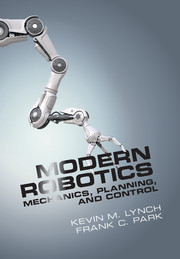Book contents
- Frontmatter
- Contents
- Foreword by Roger Brockett
- Foreword by Matthew Mason
- Preface
- 1 Preview
- 2 Configuration Space
- 3 Rigid-Body Motions
- 4 Forward Kinematics
- 5 Velocity Kinematics and Statics
- 6 Inverse Kinematics
- 7 Kinematics of Closed Chains
- 8 Dynamics of Open Chains
- 9 Trajectory Generation
- 10 Motion Planning
- 11 Robot Control
- 12 Grasping and Manipulation
- 13 Wheeled Mobile Robots
- A Summary of Useful Formulas
- B Other Representations of Rotations
- C Denavit–Hartenberg Parameters
- D Optimization and Lagrange Multipliers
- Bibliography
- Index
2 - Configuration Space
Published online by Cambridge University Press: 04 June 2024
- Frontmatter
- Contents
- Foreword by Roger Brockett
- Foreword by Matthew Mason
- Preface
- 1 Preview
- 2 Configuration Space
- 3 Rigid-Body Motions
- 4 Forward Kinematics
- 5 Velocity Kinematics and Statics
- 6 Inverse Kinematics
- 7 Kinematics of Closed Chains
- 8 Dynamics of Open Chains
- 9 Trajectory Generation
- 10 Motion Planning
- 11 Robot Control
- 12 Grasping and Manipulation
- 13 Wheeled Mobile Robots
- A Summary of Useful Formulas
- B Other Representations of Rotations
- C Denavit–Hartenberg Parameters
- D Optimization and Lagrange Multipliers
- Bibliography
- Index
Summary
A robot is mechanically constructed by connecting a set of bodies, called links, to each other using various types of joints. Actuators, such as electric motors, deliver forces or torques that cause the robot's links to move. Usually an endeffector, such as a gripper or hand for grasping and manipulating objects, is attached to a specific link. All the robots considered in this book have links that can be modeled as rigid bodies.
Perhaps the most fundamental question one can ask about a robot is, where is it? The answer is given by the robot's configuration: a specification of the positions of all points of the robot. Since the robot's links are rigid and of a known shape,1 only a few numbers are needed to represent its configuration. For example, the configuration of a door can be represented by a single number, the angle θ about its hinge. The configuration of a point on a plane can be described by two coordinates, (x, y). The configuration of a coin lying heads up on a flat table can be described by three coordinates: two coordinates (x, y) that specify the location of a particular point on the coin, and one coordinate (θ) that specifies the coin's orientation. (See Figure 2.1).
The above coordinates all take values over a continuous range of real numbers. The number of degrees of freedom (dof) of a robot is the smallest number of real-valued coordinates needed to represent its configuration. In the example above, the door has one degree of freedom. The coin lying heads up on a table has three degrees of freedom. Even if the coin could lie either heads up or tails up, its configuration space still would have only three degrees of freedom; a fourth variable, representing which side of the coin faces up, takes values in the discrete set ﹛heads, tails﹜, and not over a continuous range of real values like the other three coordinates.
Definition 2.1 The configuration of a robot is a complete specification of the position of every point of the robot. The minimum number n of real-valued coordinates needed to represent the configuration is the number of degrees of freedom (dof) of the robot.
- Type
- Chapter
- Information
- Modern RoboticsMechanics, Planning, and Control, pp. 10 - 49Publisher: Cambridge University PressPrint publication year: 2017

